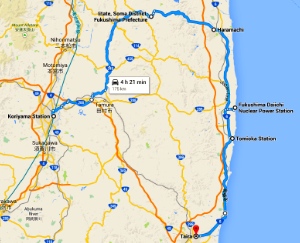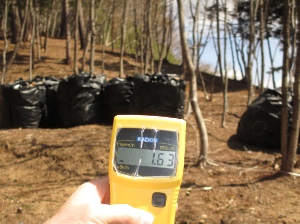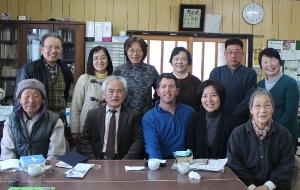 Soohwan Park has visited the site of the Fukushima nuclear disaster in Japan several times. Here she describes her most recent visit, over the Easter season.
Soohwan Park has visited the site of the Fukushima nuclear disaster in Japan several times. Here she describes her most recent visit, over the Easter season.
Check out Soohwan Park’s blog on Fukushima and the upcoming (May 7 – June 25) Fukushima to Vancouver 2015 Art Exhibition.
Via Dolorosa 2015 – Highway No. 6 in Fukushima
It was Thursday before Palm Sunday. The four of us (Shihoko and Ken Warren, myself and Midori – my Japanese friend and translator) travelled together from Minamisoma to Iwaki. We drove by the Fukushima Daichi nuclear power plant on the recently reconnected Highway No. 6 from north to south.
It was a sombre experience looking over the contaminated land and vegetation at the cooling towers just few hundred meters away, rather than looking at a flat screen with the towers thousands of miles away. Every village we passed, every mile we drove on that road felt like a retelling of the story of Jesus on the way to the cross, Via Dolorosa.
It was Ken and Shihoko’s first time to Fukushima. Two years ago, out of lament and grief of the Fukushima disaster, with their brand-new Japanese multicultural congregation at Church of All Nations, they started a holistic discipleship program around creation care in Surrey called New Eden Ministry. (read the story about their harvest celebration last year).
At Fukushima’s sites of devastation, Ken, who is a professional horticulturalist, had many moments of tears welling up. He said to us: “We have undone the 500 years of God’s work in creation.”
The 20 km exclusion zone has now shrunk to a 5 km radius from the nuclear power plant – closer in some areas, depending on the level of radiation and the progress of cleanup work. The road was reconnected just weeks before our visit and parts of the railway have begun to carry passenger trains again.
There are still no signs of residents returning or businesses opening, other than business motels and convenience stores open for the recent arrival of temporary workers from all over Japan for radiation cleanup.
Everywhere there were walls of black bags filled with the contaminated topsoil removed from the field. We were told there were some Filipino and Indian migrant workers who came for the job because it is high-paying labour, even though it comes with the high risk of radiation exposure. Those black bags will be stored away for decades until the soil is made reusable.
Apart from the ecological journey, there are complex and rapid changes in demographics and social make up of what were previously quietly aging, fishing and farming towns. In just four years the landscape of Fukushima has been turned upside down, forever.
Two years ago I wrote a story about Fukushima for Christianity Today to share with Christian leaders in relief and development about how disaster relief could be done differently – more aligned with the biblical story, and with more holistic approaches at all levels.
Essentially, working with and honouring, not bypassing, the role of local churches in disaster-stricken communities is the way forward if we are to overcome the problems of secularization and professionalization of Christian relief.
For that reason, I called this new way of integrated Christian relief work, Relational Relief – a ministry of Holy Saturday. Caught between the death and suffering of Good Friday and the victorious resurrection of Easter Sunday. Because the work of Christian relief isn’t simply about rebuilding what was lost before the disaster, but about building communities of Easter Hope.
Building communities of Easter hope
Through my regular visits to Fukushima since April 2011 I have continued to write stories on my blog, En Route to Fukushima. I’ve kept an account of what that work of building communities of Easter hope from ground up might look like, learning from the small churches that have shown what obedience and risk-taking means.
In every visit, with my Japanese colleague’s translation (sometimes just the Holy Spirit’s prompting my senses), we carefully asked the four following questions to every pastor and community leader we encountered:
-
How does he/she follow Christ’s call through this disaster?
-
What is the unique spiritual gift of this church in restoring the social fabric of Fukushima (and Japanese society)?
-
What is their God-given, long-term vision for building community?
-
What is an emerging model of local community engagement unique to the church’s story, DNA and leadership gifts?
What we learned was the retelling of faithful actions of ancient Christians in Fukushima in four building blocks for communities of Easter hope:
-
Relief work isn’t just providing material handouts, but providing holistic restoration including social, emotional recovery. (Example story)
-
Genuine motives speak louder. If a local church approaches disaster victims with a hidden agenda to evangelize it only works against the gospel. (Example story)
-
Community service is an integral part of the discipleship journey. (Example story)
-
Theology of martyrs: One must overcome the fear of death inside and die to herself. Only then she can take up the cross and follow Jesus wherever he might go. (Example story)
Through their tenacious and resilient work in their communities, this was a journey of learning from the local churches in Fukushima for the rest of us. Interestingly, these churches share some common characteristics with some local churches in Vancouver: They are small, mainly seniors filling the pews on Sundays in a rapidly aging society; often they are insignificant minorities in a society where wealth, individualism and self-reliance are the much-praised norm.
 Challenges on the road to Emmaus
Challenges on the road to Emmaus
Building communities of Easter hope is not an easy task. It takes generations and goes beyond the life cycle of a leader. It is especially hard when a local church (or a group of local churches) is faced with multitudes of challenges as time goes by after a major disaster like this.
The world has forgotten about the disaster. No seminary courses or textbooks will come in handy for questions rising from the fallout of modern economic pursuits like the Fukushima Daichi’s nuclear failure.
Despite the conventional expectations of increased opportunities for evangelism after the disaster relief, churches are still small. They are often poorly equipped to prepare leaders other than being busy multi-tasking pastors. Many pastors, lay leaders and volunteers who were active at the disaster relief are struggling with burnout, overwork, secondary traumatization or other PTSD related issues. The first three years after the disaster seem like relatively smooth sailing compared to the challenges now on the horizon.
I came to understand that a challenge even worse than the disaster itself might come our way if we weren’t careful about how the post-relief stage is built. I prayed that God may call more people to Fukushima even just to visit the place and witness the stories of powerful hope rising from the local churches.
Very few people go to Fukushima these days. Just visiting there and hearing the stories firsthand from local people can be a huge ministry and encouragement. I felt I had to continue to visit every year and to write the stories for any listening ear.
After Jonathan (my husband) came with me three years ago, Shihoko and Ken were among those few listening ears and now joined the journey to Fukushima, not simply to go to Fukushima but to bring Fukushima back to Vancouver in their New Eden Ministry.
During our visits to Koriyama, Minamisoma and Iwaki, we were warmly welcomed by the pastors and church members with whom I have had the privilege of building friendships over the last four years.
We were thrilled at the grand vision Rev. Sumiyoshi is moving forward. Fukushima: Happy Island project is an integrated Christian approach toward community building. Jeremiah 29:7 has provided a major paradigm shift for him since the disaster and he started practical ways of extending his church for serving the community and connecting with other local churches in disaster-stricken East Japan.
Now he is preparing to start a new community centred around the restoration of the land and socio-economic recovery in Fukushima. Ken and Shihoko were especially delighted to discover the common vision behind this project and New Eden in Vancouver that God’s mysterious plans for restoring the creation are now being carried through both in Fukushima and Vancouver.
Local church is a global community
Fukushima’s problem isn’t an isolated one. We are all connected. We all have a part in bringing solutions at both the local and global level. The work of professional relief organization is over in Fukushima. The 20th century model of sending individual missionaries does not fit the holistic picture either. Christian development organizations have expertise working in developing countries, but not in a post-capitalist, ‘overdeveloped’ country like Japan.
What does global mission and partnership look like in this situation as the local churches in Fukushima quietly and painfully continue marching on the road to building communities of Easter hope?
We have something to share with Fukushima, but we have so much more to learn from the small, resilient local churches in Fukushima. What might be our journey toward building communities of Easter hope in our neighbourhoods in Vancouver? How we might journey together with those in thousands of miles away for building a global community of Easter hope? This is the prayer Ken, Shihoko and I did when we left Fukushima on our way back to Vancouver.




Hello Soohwan:
Thank you for your thoughtful articles on the tsunami followup to the Fukushima area of Japan. I had the honour of visiting the Tohoku region last October, doing 11 piano concerts in 10 days on a testimony missions trip for churches in Yokohama, Shizuoka, Tanohata, Noda, Omoto, Matsushima, Ishinomaki, Nishikiori, Miharu and Taira. I will be giving a report of this tour and the just completed Germany missions trip at Tenth Church (11 W. 10th Ave.) on Sun. May 24th at 1 pm. If this interests you or your colleagues, please feel free to contact me for details or just come on by 🙂 May God bless you as you bring His hope to those in Japan and Vancouver.
Hi Julie,
Thanks for your kind reply. Praise the Lord for your music ministry. please send me the details of your upcoming concert to FukushimaToVancouver@gmail.com. I will share with friends. thank you.